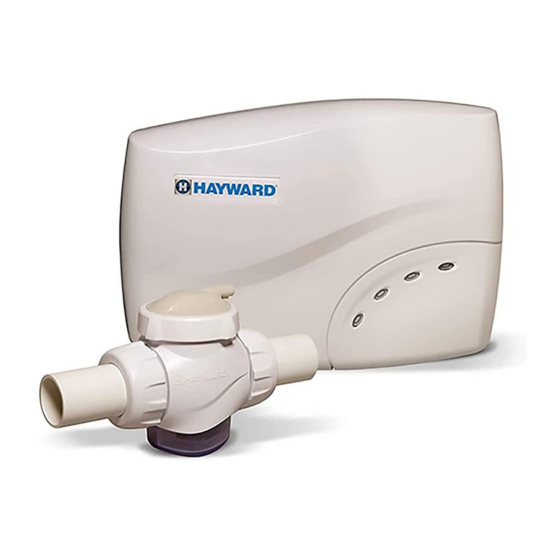
Hayward Salt & Swim Quick Start Manual
Salt & swim chemistry quick start guide
Hide thumbs
Also See for Salt & Swim:
- Owner's manual (25 pages) ,
- Installation & quick start manual (2 pages) ,
- Quick start (1 page)
Table of Contents
Advertisement
Quick Links
Download this manual
See also:
Owner's Manual
OVERVIEW
Before attempting to operate your new chlorine
generator, salt must be added to your pool and
your pool's water chemistry must be properly
balanced. Properly balanced pool water is not
only necessary for chlorine generation, but also
to protect your pool equipment and users of the
pool.
BECAUSE SOME CHEMICALS INFLUENCE
MORE THAN ONE CHEMISTRY PARAMETER,
IT IS IMPORTANT THAT YOU FOLLOW THE
STEPS IN THE ORDER PRESENTED.
The following steps require the use of a reliable
pool chemical test kit(s).
STEP 3:
Adjust Cyanuric Acid
Cyanuric Acid (Stabilizer) is very important to
the performance of your chlorine generation
system. It's a mild acid that helps prevent
the breakdown of chlorine due to the sun's
ultraviolet rays.
IDEAL LEVEL: 60 - 80 ppm outdoor pools
20 - 40 ppm covered pools
0 ppm indoor pools
Test your pool's Cyanuric Acid level using a
pool test kit or bring a water sample to your
local pool store.
Refer to Table 2 to determine the amount of
Cyanuric Acid needed to raise the Cyanuric
Acid to the desired level.
WWW.HAYWARD.COM
855-429-9274
CHEMISTRY QUICK START GUIDE
STEP 1:
Calculate Pool Volume
Determine the total number of gallons of water in your
pool using the formulas below. This calculation will be
used frequently when adjusting pool chemical levels
so take care when measuring. For non-standard
shaped pools, it may be easier to break the pool up
into "sections" to make the calculations. When done,
add all the "sections" to determine the total volume of
your pool.
GALLONS
(pool size in feet)
Length x Width x
Rectangular
Average Depth x 7.5
Diameter x Diameter x
Round
Average Depth x 5.9
Length x Width x
Oval
Average Depth x 6.7
STEP 4:
Adjust Total Alkalinity
Total Alkalinity (TA) is a measure of the total
alkaline substances found in the pool water.
The results of improper TA levels range from
corrosion of metal pool parts, staining of the
pool, burning eyes, cloudy water and reduced
chlorine efficiency.
IDEAL LEVEL: 80 - 120 ppm
Test your pool's TA.
Refer to Table 3 to increase the pool's TA using
Baking Soda (Sodium Bicarbonate 100%).
Refer to Table 4 to decrease the pool's TA using
Muriatic Acid (Hydrochloric Acid 31.45%).
STEP 2:
IDEAL RANGE: Before adding salt, test your pool water for the current
level of salt.
RECOMMENDED LEVEL: 2700 - 3400 ppm (3200 ppm ideal)
After testing salt, refer to Table 1 to determine how much salt must be added
to achieve a level of 3200 parts per million (ppm).
LITERS
Salt should be added directly to the pool with the pool pump on. Brush the
(pool size in meters)
salt around to speed up the dissolving process - do not allow the salt to
pile up on the bottom of the pool. For new plaster pools, wait 10-14 days
Length x Width x
before adding salt to allow the plaster to cure. Run the filter pump for 24
Average Depth x 1000
hours with the suction coming from the main drain (use pool vac if there is
Diameter x Diameter x
no main drain) to allow the salt to evenly disperse throughout the pool.
Average Depth x 785
Length x Width x
Use common food quality salt usually available in 40-80 lb. bags labeled
Average Depth x 893
"Pool Salt" or "Coarse Solar Salt". Do not use rock salt, salt with yellow
prussiate of soda, salt with anti-caking additives, or iodized salt.
STEP 5:
Adjust Total Hardness
Total Hardness is the measurement of the total
amount of minerals that are found in your pool's
water. Too much calcium hardness will cause
scaling in your pool and too little will cause the
pool water to become corrosive.
IDEAL LEVEL: 200 - 400 ppm
Test your pool's Total Hardness.
If low, add Calcium Chloride (77%) according
to Table 5.
If Total Hardness is high, dilute or replace the
pool water.
Adjust Salt Level
STEP 6:
Adjust pH
pH is the measure of how acid/alkaline the
pool water is. If pH is too low, the water can
be corrosive to pool equipment. If pH is too
high, then the chlorine becomes much less
effective for sanitization.
IDEAL LEVEL: 7.2 - 7.8
Test your pool's pH.
To increase the pool's pH, add Soda Ash
according to Table 6.
To decrease pool pH, add Muriatic Acid
according to Table 7.
Advertisement
Table of Contents

Summary of Contents for Hayward Salt & Swim
- Page 1 Refer to Table 2 to determine the amount of Refer to Table 4 to decrease the pool’s TA using according to Table 7. pool water. Cyanuric Acid needed to raise the Cyanuric Muriatic Acid (Hydrochloric Acid 31.45%). Acid to the desired level. WWW.HAYWARD.COM 855-429-9274...
- Page 2 (12.2) (16.2) (20.9) 50 ppm (1.4) (1.6) (1.4) (1.6) (1.8) (2.0) (2.3) (2.5) (2.7) 60 ppm (.91) (1.1) (.91) (1.1) (1.2) (1.4) (1.5) (1.7) (1.8) 70 ppm (.45) (.54) (.45) (.54) (.64) (.68) (.77) (.82) (.91) 80 ppm WWW.HAYWARD.COM 855-429-9274...



Need help?
Do you have a question about the Salt & Swim and is the answer not in the manual?
Questions and answers